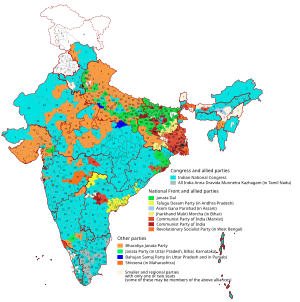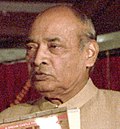
The Indian National Congress (INC), colloquially the Congress Party or simply the Congress, is a political party in India with deep roots in most regions of India. Founded on 28 December 1885, it was the first modern nationalist movement to emerge in the British Empire in Asia and Africa. From the late 19th century, and especially after 1920, under the leadership of Mahatma Gandhi, the Congress became the principal leader of the Indian independence movement. The Congress led India to independence from the United Kingdom, and significantly influenced other anti-colonial nationalist movements in the British Empire.

Vishwanath Pratap Singh, shortened to V. P. Singh, was an Indian politician who was the 7th Prime Minister of India from 1989 to 1990 and the 41st Raja Bahadur of Manda.

Haradanahalli Doddegowda Deve Gowda is an Indian politician who served as the 11th prime minister of India from 1 June 1996 to 21 April 1997. He was previously the 14th Chief Minister of Karnataka from 1994 to 1996. He presently is a Member of Parliament in the Rajya Sabha representing Karnataka. He is the national president of the Janata Dal (Secular) party. Born in a farming family, he joined the Indian National Congress party in 1953, and remained a member until 1962. He was imprisoned during the Emergency. He became President of the state unit of Janata Dal in 1994, and was considered to be a driving force in the party's victory in Karnataka. He served as the 8th Chief Minister of Karnataka from 1994 to 1996. In the 1996 general elections, no party won enough seats to form a government. When the United Front, a coalition of regional parties, formed the central government with the support of the Congress, Deve Gowda was unexpectedly chosen to head the government and was elected Prime Minister. During his tenure as prime minister, he also served as Home Minister for some time. His prime ministerial tenure lasted for less than a year. After his prime ministerial tenure, he was elected to the 12th (1998), 14th (2004), 15th, and 16th Lok Sabha, as Member of Parliament for the Hassan Lok Sabha constituency. He lost Lok Sabha elections in 2019 from Tumkuru but has been elected to Rajya Sabha since.

Janata Dal was an Indian political party which was formed through the merger of Janata Party factions, the Lok Dal, Indian National Congress (Jagjivan), and the Jan Morcha united on 11 October 1988 on the birth anniversary of Jayaprakash Narayan under the leadership of V. P. Singh.

Madhavrao Jivajirao Scindia was an Indian politician and a minister in the Government of India. He was a member of the Indian National Congress party.

Chaudhary Ajit Singh was an Indian farmer leader and politician. He was the founder and chief of the Rashtriya Lok Dal, a political party recognised in the state of Uttar Pradesh. He was son of the former Prime Minister of India Chaudhary Charan Singh. He tested positive for COVID-19 and was subsequently admitted to a hospital in Gurugram. He died on 6 May 2021 after his condition deteriorated.

Selja Kumari is an Indian politician and former parliamentarian. A member of the Indian National Congress, she has been the Minister of Social Justice and Empowerment and Tourism in the Government of India during Manmohan Singh's premiership.

Vilas Bhaurao Muttemwar is an Indian politician from Maharashtra belonging to the Indian National Congress who served as a member of the 7th, 8th, 10th, 12th, 13th, 14th and 15th Lok Sabha representing the Nagpur Lok Sabha constituency.

Vidya Charan Shukla was an Indian politician whose political career spanned six decades. He was predominantly a member of the Indian National Congress, but also had spells in Jan Morcha, Janata Dal, Samajwadi Janata Party (Rashtriya), Nationalist Congress Party and Bharatiya Janata Party. He was known as a close associate of Indira Gandhi.
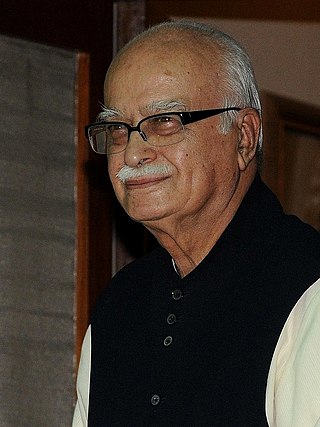
General elections were held in India on 22 and 26 November 1989 to elect the members of the ninth Lok Sabha. The incumbent Indian National Congress (Indira) government under the premiership of Rajiv Gandhi lost its mandate, even though it was still the largest single party in the Lok Sabha. V. P. Singh, the leader of the second largest party Janata Dal was invited by the President of India to form the government. The government was formed with outside support from the Bharatiya Janata Party and Communist parties led by CPI(M). V. P. Singh was sworn in as the seventh Prime Minister of India on 2 December 1989.
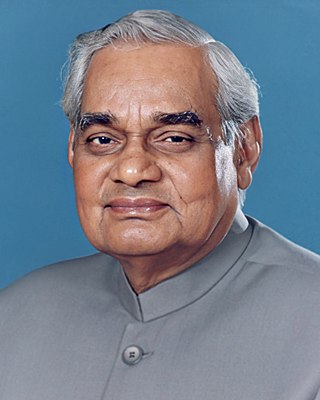
General elections were held in India on 27 April, 2 May and 7 May 1996 to elect the members of the eleventh Lok Sabha. The elections resulted in a hung parliament with no single party having a clear majority. The Bharatiya Janata Party, which had won the most seats, formed a short-lived government under Prime Minister Atal Bihari Vajpayee. However, two weeks later the United Front coalition was able to secure a parliamentary majority and H. D. Deve Gowda of Janata Dal became Prime Minister. In 1997 Inder Kumar Gujral, also from the United Front, succeeded Gowda as Prime Minister. Due to the instability, early elections were held in 1998. The elections were the first since 1980 in which every states' seats were elected in a single election period.
Phanindranath Rangarajan Kumaramangalam was a prominent politician of the Indian National Congress and later the Bharatiya Janata Party and a Member of parliament, Lok Sabha from the Salem constituency from 1984 to 1996 and Tiruchirapalli constituency from 1998 to 2000. He served as the Minister of State for Law, Justice and Company Affairs in the P. V. Narasimha Rao government from July 1991 to December 1993 and as the Union Minister for Power in the Vajpayee Government from 1998 to 2000. He was the grandson of former Chief Minister of Madras, P. Subbarayan and the nephew of former Indian Chief of Army, General P. P. Kumaramangalam.

Chandra Shekhar, known as Jananayak, was an Indian politician who served as the 8th Prime Minister of India, between 10 November 1990 and 21 June 1991. He headed a minority government of a breakaway faction of the Janata Dal with outside support from the Indian National Congress. He was the first Indian Prime Minister who had never held any prior government office.

Pamulaparthi Venkata Narasimha Rao, popularly known as P. V. Narasimha Rao, was an Indian lawyer, statesman and politician who served as the 9th prime minister of India from 1991 to 1996. He was the first person from South India and second person from non-Hindi speaking background to be the prime minister. He is especially known for introducing various liberal reforms to India's economy by recruiting Manmohan Singh as the finance minister to rescue the state from going towards bankruptcy during the economic crisis of 1991. Future prime ministers, Atal Bihari Vajpayee and Manmohan Singh, continued the economic reform policies pioneered by Rao's government. Rao was also referred to as Chanakya for his ability to steer economic and political legislation through the parliament at a time when he headed a minority government.

The Leader of the House in Lok Sabha is the parliamentary chairperson of the party that holds a majority in the Lok Sabha and is responsible for government business in the house. The office holder is usually the prime minister if they are a member of the house. If the prime minister is not a member of the Lok Sabha, usually the senior-most minister in the union cabinet serves as the leader of the house.
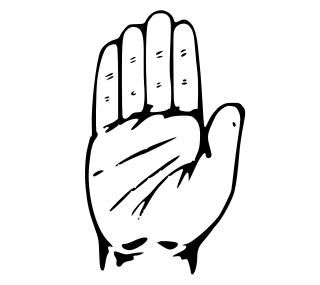
Legislative Assembly elections were held in the Indian state of West Bengal in 1996. The election took place simultaneously with the 1996 Indian general election. This was the last election Jyoti Basu contested, as he retired from politics in 2000.
In June 1992 a by-election was held for the New Delhi seat in the Lok Sabha. The by-election was called after the resignation of the incumbent Member of Parliament L.K. Advani.

The 1991 Indian general election were held to elect 20 members to the tenth Lok Sabha from Kerala. Indian National Congress (INC)-led United Democratic Front (UDF) won 16 seats while Left Democratic Front (LDF), led by Communist Party of India (Marxist) won the remaining 4 seats. Turnout for the election was at 70.66% In the Lok Sabha, INC formed a minority government under the premiership of P. V. Narasimha Rao.
General elections were held in India in 1991 to elect the members of the 10th Lok Sabha. Voter turnout was the lowest ever in parliamentary elections. No party could muster a majority in the Lok Sabha, hence INC formed a minority government with the support of other parties, resulting in a stable government for the next 5 years under the new Prime Minister P. V. Narasimha Rao. BJP wins 20 seats, Congress wins 5 seats and JD (G) wins only one seat.
